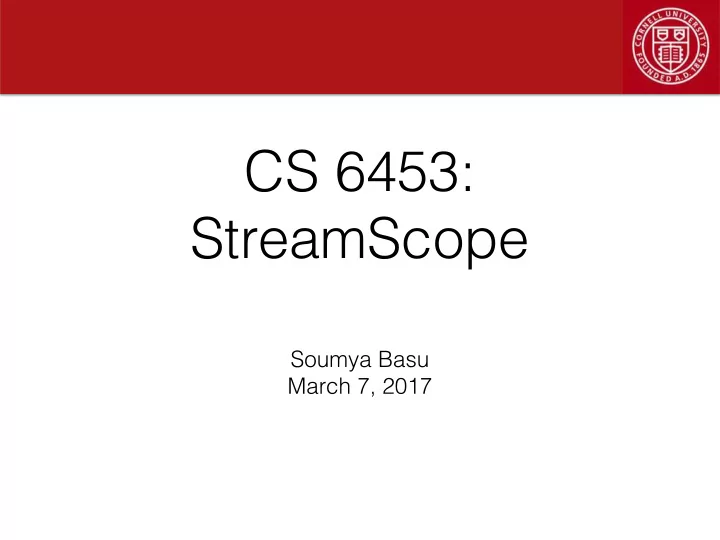

CS 6453: StreamScope Soumya Basu March 7, 2017
Motivation • Streaming data is everywhere! • Updates on Facebook • Shopping on Alibaba • Singles Day in China: 50 million events per sec, 3 second latency
Streaming Problem • Infinite stream of input events to process • Want to produce output events in a timely fashion • Stream processing is rather complex • However, there are key constraints (e.g. cannot keep per-event state around)
Prior Works • Many pieces of the StreamScope paper are lifted from prior works • SQL-like programming interface • Compiling and optimizing the program to a DAG • Scheduling tasks on a cluster
Related Work • Extending batch processing systems to streaming • MapReduce Online, S4, Storm • Different design dimensions explored in stream processing: • Photon, Jetstream: geo-distribution • Naiad, Flink: Dataflows with cycles
Where is this work new? • Strong consistency, high scalability, and a cleaner abstraction • The latter allows for easily reasoning about many other problems
Model • Every stream computation can be broken up using 2 types of components: • Streams: Which are ordered lists of events • Vertices: Read from many input streams, produce one output stream • TODO: Insert picture here of model
Key Idea: Reliability • Make both components reliable and consistent • Called rVertex and rStream in the paper • Assumption on rVertex: the programs written are deterministic • Reliability allows for easy reasoning to solve many other problems
Failure Recovery: rVertex • Failure Recovery has only two cases! • Option 1: Periodic snapshots taken during steady state • Upon failure, restore to recent snapshot and read next events from stream • Option 2: Run many copies of the same rVertex
Failure Recovery: rStream • Asynchronously flush stream state to disk • If stream fails, recompute recent events from incoming rVertex • Again, determinism assumption used heavily here!
Stragglers • Much larger problem in stream processing • A straggler can cause slowdown long after it’s no longer a problem • Handled the same way as failures: • Spin up new rVertex in parallel with the original • Kill the slow one after a while • Benefit: doesn’t sacrifice latency for slow events
Other Issues • Handling bursts with rStream is trivial since the underlying storage is on disk • Maintenance handled like a failure/straggler • Time traveling and replay is possible by storing old rStream/rVertex state
Evaluation
Limitations • Nondeterminism • Input streams are often nondeterministic (e.g. a click stream) • Reliability issues still exist in this system • Many consistency issues are folded in this assumption
What Next? • How do we handle nondeterminism efficiently? • Is there a way to capture all nondeterministic sources? • Can rVertex and rStream abstractions be extended to cycles as well? • What’s the inherent difficulty in doing that?
Recommend
More recommend